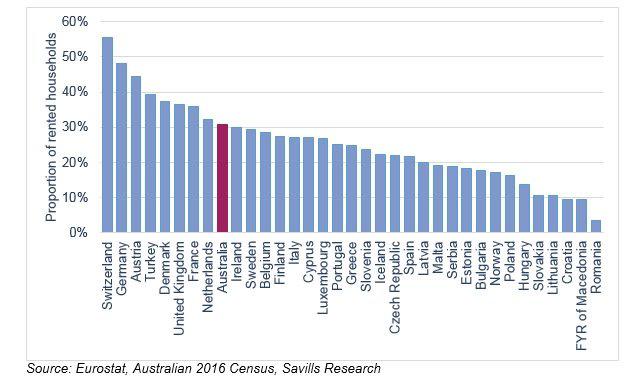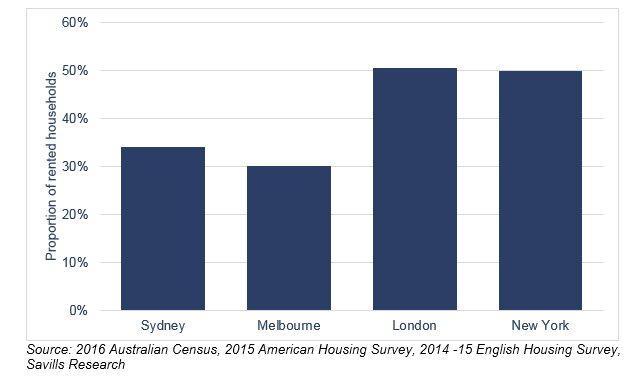Australia’s Renting Trends: How do they compare to the rest of the world?
The results from the 2016 Census have shown that the trend towards renting rather than owner-occupying has continued.
Australian renters now account for 30.9% of the population in 2016; a slight increase from 29.6% in 2011 and a five percent shift since 2001.
Savills Head of Residential Research, Sophie Chick, explains that the trend is not unique to Australia.
In 2015, the latest data available from Eurostat reported that 30.6% of the EU-28 population lived in rented accommodation, although this varied widely country to country.
“Switzerland, Germany and Austria have the highest proportion of renters, accounting for over 45% of the population," Chick said.
"At the other end of the spectrum, in Croatia, Macedonia and Romania less than 10% of the population rent. Australia has a similar level to the Netherlands and Ireland."

Renting in Australia vs European countriesDifference in attitude
This variation is down to a number of factors including the local economy, housing finance availability and government policy but, perhaps the most interesting, is the difference in attitude towards renting.
In Germany, renting is the norm and the sector has a good supply of high quality rental accommodation and favourable tenant conditions.
By comparison, many of the countries with high levels of homeownership are in former communist nations where the rapid privatisation of public rental housing in the 1990s resulted in high homeownership rates.
Australia is similar to the UK in both attitude and rental conditions. Homeownership has traditionally been considered the "Great Australian Dream", particularly owning a detached house.
Attitudes seem to be shifting as younger generations are willing to rent for longer in more desirable, central locations close to work and amenities rather than buy a property on the outskirts of a city.
An urban phenomenon
"It is no surprise that the locations with the biggest increase in the proportion of renters are Melbourne and Sydney, considering the large price increases and high median property values," Chick said.
"Again, this is not exclusive to Australia. Global cities worldwide have seen very high levels of price growth over the past decade, often pricing the younger generations out of homeownership or delaying it.
"Nevertheless, the rental population in Sydney and Melbourne is still some way off the levels seen in London and New York.
"Renters account for around one third of the population in the Australian cities compared to half in London and New York.
"It is worth noting that one of the biggest differences is the level of social renting, which accounts for just five percent in Sydney compared to 23% in London," she said.

Renting in Sydney and Melbourne vs London and New YorkA long term solution?
Ms Chick said while attitudes are shifting, homeownership is still the ultimate goal for the majority of Australians unlike countries such as Germany and the US.
Part of the reason is the lack of stable, suitable rental accommodation.
“However, the popular long term rental model, called multi-family in the US and build to rent in the UK, is beginning to gain interest here from large scale institutions," Chick said.
"This is likely to be a welcome change for renters in Australia, as the product offers more choice and stability in the sector.
“In time, renting could become a way of life rather than something to do while saving up to buy a house."













